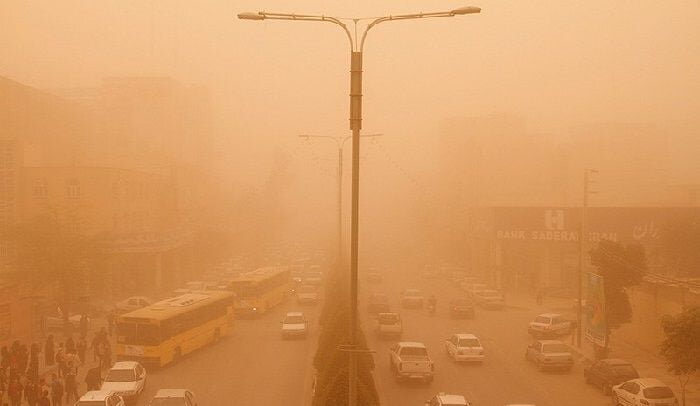Borderless collaboration for a borderless disaster

TEHRAN – Sand and dust storms (SDSs) are blowing thousands of kilometers in and out of the national borders of 150 countries these days, and their statelessness necessitates negotiations for political intervention between several countries.
Sand and dust storms are common meteorological hazards in arid and semi-arid regions. They are usually caused by thunderstorms – or strong pressure gradients associated with cyclones – which increase wind speed over a wide area.
These strong winds lift large amounts of sand and dust from bare, dry soils into the atmosphere, transporting them hundreds to thousands of kilometers away.
The main sources of this mineral dust are the arid regions of Northern Africa, the Arabian Peninsula, Central Asia, and China. Comparatively, Australia, America, and South Africa make minor, but still important, contributions.
Global estimates of dust emissions, mainly derived from simulation models, vary about two billion tons per year, about 27 percent of which originates in Asia-Pacific.
Currently, dust storms are a major challenge to sustainable development, especially in arid and semi-arid regions, where more than 151 countries are directly affected, and 45 countries are classified as SDS source areas, according to UNCCD.
Dust storm belts range from the Sahara Desert and West Asia to the Great Desert of India and the deserts of central latitudes of Central Asia, China, and Mongolia. Thus, with such a wide range of cross-border effects, managing dust storms requires global and regional cooperation.
The most important factors of dust storms are land degradation, desertification, climate change, unsustainable land, and water use, strong winds, increasing drought, and its severity over time.
Natural sources of SDSs (including dried lakes and rangelands affected by vegetation depletion) account for 75 percent of the world’s dust emissions and the share of human-caused SDSs (such as land-use change, agriculture, water diversion, and deforestation) is about 25 percent.
Dust storms have both internal and external origins, but their negative consequences are very wide and include serious risks to human health up to major economic losses in the fields of transportation, agriculture, water, and air quality.
Impacts on human health
Airborne dust presents serious risks for human health. Dust particle size is a key determinant of the potential hazards to human health. Particles larger than 10 micrometers are not breathable, thus can only damage external organs – mostly causing skin and eye irritations, conjunctivitis, and enhanced susceptibility to ocular infection.
Inhalable particles, those smaller than 10 micrometers, often get trapped in the nose, mouth and upper respiratory tract thus can be associated with respiratory disorders such as asthma, tracheitis, pneumonia, allergic rhinitis, and silicosis.
However, finer particles may penetrate the lower respiratory tract and enter the bloodstream, where they can affect all internal organs and be responsible for cardiovascular disorders. A global model assessment in 2014 estimated that exposure to dust particles caused about 400,000 premature deaths by cardiopulmonary disease in over 30 populations.
Globally, 334 million people and 14 percent of the world’s children experience asthmatic symptoms.
Some infectious diseases can be transmitted by dust. Meningococcal meningitis, a bacterial infection of the thin tissue layer that surrounds the brain and spinal cord, can result in brain damage and, if untreated, death in 50 percent of cases.
Outbreaks occur worldwide, yet the highest incidence is found in the “meningitis belt”, a part of sub-Saharan Africa with an estimated population of 300 million. These outbreaks have a strong seasonal pattern – many studies have linked environmental conditions, such as low humidity and dusty conditions, to the time and place of infections.
Researchers believe that the inhalation of dust particles in hot dry weather may damage nose and throat mucosa creating favorable conditions for bacterial infection. Moreover, iron oxides embedded in dust particles may enhance the risk of infection.
Dust also plays a role in the transmission of valley fever – a potentially deadly disease – in the Southwest of the United States and in Northern Mexico by acting as a transporter of Coccidioides fungi spores.
Internal SDSs hotspots
Masoud Tajrishi, deputy head of the Department of Environment (DOE) for the human environment stated in June that a total budget of €450 million has been earmarked to contain sand and dust storms (SDSs) nationwide over the past three years.
Accordingly, in 2017, a special working group called "national headquarters for SDSs control" was formed, which has been able to manage this issue to a very good extent, he further highlighted.
Tajrishi went on to state that the headquarters first identified internal and external dust hotspots, based on which it was determined that about 35 million hectares are generating dust in the country, two million hectares of which are in critical condition.
Studies have shown that 40 percent of the critical dust sources are dried wetlands. To manage this section, we are going to have a meeting with the Ministry of Energy, he added.
About 350 million hectares of surrounding countries affect Iran, which is mainly raised from Iraq, Syria, Saudi Arabia, Afghanistan, the United Arab Emirates, Oman, and Turkmenistan, he noted, adding, so that the Ministry of Foreign affairs started negotiations with the international community to tackle the problem.
During this period, about 110,000 hectares undergone seedling plantation, more than 750,000 hectares of protection, trapping and grazing operations in pastures with dust-raising potential, soil stabilization in 150,000 hectares, including mulching, construction of live and non-living windbreaks, equipping 100 stations for forecasting and warning, about 360 thousand cubic meters of dredging operations, improving routes for water to reach wetlands and about 100 kilometers of water transmission channels to humidify areas with dust potential in 27 dusty provinces were among the actions have been taken, he explained.
FB/MG
Leave a Comment